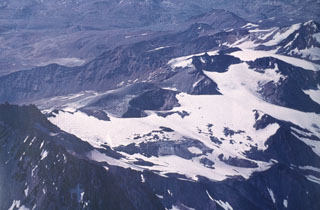Report on Planchon-Peteroa (Chile) — 27 April-3 May 2011
Smithsonian Institution / US Geological Survey
Weekly Volcanic Activity Report, 27 April-3 May 2011
Managing Editor: Sally Sennert.
Please cite this report as:
Global Volcanism Program, 2011. Report on Planchon-Peteroa (Chile) (Sennert, S, ed.). Weekly Volcanic Activity Report, 27 April-3 May 2011. Smithsonian Institution and US Geological Survey.
Planchon-Peteroa
Chile
35.223°S, 70.568°W; summit elev. 3977 m
All times are local (unless otherwise noted)
SERNAGEOMIN reported that during 1-15 April a camera installed in Romeral, approximately 61 km NW of Planchón-Peteroa, recorded predominantly white vapor plumes that rose at most 600 m. During 16-19, 21 and 25-29 April episodes of ash-plume production changed from discreet plumes to more continuous emissions. Ash plumes during 17-19 and 29 April rose 1.2 km and contained ash- to lapilli-sized particles. During overflights on 26, 27, and 29 April, a geologist noted that the crater geometry and fumarolic activity had changed very little during the previous few months and that ash emissions drifted mainly SW. SERNAGEOMIN stated that because ash-and-gas emissions were becoming almost continuous, the Alert Level was raised to Level 3, Yellow on 29 April. Based on analyses of satellite imagery, SIGMET notices, and ODVAS web camera observations, the Buenos Aires VAAC reported that during 2-3 May gas-and-ash plumes rose to altitudes of 4.6-5.5 km (15,000-18,000 ft) a.s.l. and drifted NE and E.
Geological Summary. Planchón-Peteroa is an elongated complex volcano along the Chile-Argentina border with several overlapping calderas. Activity began in the Pleistocene with construction of the basaltic-andesite to dacitic Volcán Azufre, followed by formation of basaltic and basaltic-andesite Volcán Planchón, 6 km to the north. About 11,500 years ago, much of Azufre and part of Planchón collapsed, forming the massive Río Teno debris avalanche, which traveled 95 km to reach Chile's Central Valley. Subsequently, Volcán Planchón II was formed. The youngest volcano, andesitic and basaltic-andesite Volcán Peteroa, consists of scattered vents between Azufre and Planchón. Peteroa has been active into historical time and contains a small steaming crater lake. Historical eruptions from the complex have been dominantly explosive, although lava flows were erupted in 1837 and 1937.
Sources: Servicio Nacional de Geología y Minería (SERNAGEOMIN), Buenos Aires Volcanic Ash Advisory Center (VAAC)

